Star Wars a New Hope Sound Design
The thought of Star Wars more or less going back to the basics of what made the first trilogy so successful might sound like cinematic de-evolution in action. When seen in context of how it was done for Disney+'s The Mandalorian, one can see it was really the next step in special effects evolution.
Yes, The Mandalorian went back to some old templates for the production design, even tapping elements used during Star Wars: A New Hope. Since this was the work of George Lucas's own Industrial Light and Magic, one can say Lucas's fingerprints were still all over The Mandalorian at its core.
With the show going back to some special effects basics, what does it say for other films and shows often spending a wasteful fortune adding additional layers of CGI?
Being more practical brings more heart

If one had to study the real secret to why the original Star Wars movies were successful, it's because the special effects were practical without looking like digital noise. Practical effects sometimes look more aesthetically beautiful than what digital can offer.
As a good example, it's been recently noted some matte paintings were used in The Mandalorian, a process mostly out of use for 30 years or more. This involved taking a real background or creating a painting of one and superimposing it in an exterior shot. Some of the planet backgrounds used in The Mandalorian were mattes, including one original one depicting Tatooine used by legendary matte artist Roger McQuarrie.
Anyone unfamiliar with matte paintings may not know how ethereal these looked, a process used frequently by Disney with their iconic matte artist, Peter Ellenshaw. That aesthetic is what made Disney live-action movies have their magical "look" no one can duplicate today.
In the original Star Wars trilogy, the same processes were used, including something getting a little bit more publicity: Practical puppetry effects for The Child (Baby Yoda).
Going back to old school puppetry to bring The Child to life
The Mandalorian using practical effects and puppetry is maybe my favourite thing about it. Also how they found an actual real live baby Yoda https://t.co/0f2lGRUiQb
— Kate Leth (@kateleth) November 24, 2019
One thing nobody can deny is Yoda had far more warmth and heart when seen as a puppet in The Empire Strikes Back. This was testament to the brilliance of Frank Oz's puppetry skills and voice work.
Even though fans have seen Yoda in CGI form since then in the prequels and other Star Wars projects, he just didn't look the same with the digital sheen.
No wonder Jon Favreau wanted The Child to be operated exactly how Yoda was filmed 40+ years ago. Operated by two puppeteers, it's worth pondering whether Baby Yoda would really have been embraced by viewers had he/she/it been an entire CGI creation as producers initially wanted.
For maybe explainable reasons, the evolution of CGI seems to have worsened rather than improved. The more real it makes things look, the less appealing it is, which is a digital contradiction unfolding before everyone's eyes.
Further practical effects are maybe around the corner
Thanks to The Mandalorian and A New Hope sharing this interesting special effects connection, it's clear what the real secret was to the franchise's success. Because The Mandalorian looks different from so many CGI-lathered content out there, it's easy to see why there was an emotional reaction by initial skeptical fans.
Lifting from ILM's asset library helped the show bring a few other practical effects to cut down on the budget (or slightly anyway) to give the original and sometimes unexplainable Star Wars aesthetic. They've even used props from the first film.
The big question is whether other Star Wars projects will go back to these practical effects and have it snowball within other big films leaning heavily on CGI. After public complaints about how bad CGI looks of late, other studios should think about more practicality and have it blend in seamlessly with new technology.
If they do, Hollywood might revive the heart and soul of what made so many classic pre-1990s movies continue to hold up through repeated viewings.
Star Wars a New Hope Sound Design
Source: https://www.cheatsheet.com/entertainment/the-mandalorian-and-star-wars-a-new-hope-share-an-unexpected-major-connection.html/
0 Response to "Star Wars a New Hope Sound Design"
Post a Comment